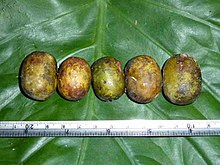Choerospondias axillaris
| Choerospondias axillaris | ||||||||||||
|---|---|---|---|---|---|---|---|---|---|---|---|---|

Choerospondias axillaris |
||||||||||||
| Systematics | ||||||||||||
|
||||||||||||
| Scientific name of the genus | ||||||||||||
| Choerospondias | ||||||||||||
| BLBurtt & AWHill | ||||||||||||
| Scientific name of the species | ||||||||||||
| Choerospondias axillaris | ||||||||||||
| ( Roxb. ) BLBurtt & AWHill |
Choerospondias axillaris is a tree in the sumac family from southern China and Taiwan to Tibet , Nepal and northern Southeast Asia . It is the only species in the genus Choerospondias
description
Choerospondias axillaris grows as a deciduous to evergreen tree up to (20) 30 meters high. The trunk diameter reaches over 40–50 centimeters. The coarse, brown bark is furrowed with age and flakes off in small strips.
The alternate and stalked leaves are unpaired pinnate with 7–17 leaflets . The petiole is up to 10-12 centimeters long. The short-stalked, almost bare and papery leaflets are ovate to lanceolate. They are up to about 12 centimeters long and up to 6 centimeters wide, pointed and completely to roughly sawn on the edge. The leaflet stalks are 5–8 millimeters long. The stipules are missing.
Choerospondias axillaris is dioecious polygamous-dioecious . The unisexual or hermaphrodite flowers appear terminal or axillary, the males are in small panicles , the larger females usually appear singly or in small clusters . The very small, stalked and five-fold flowers with a double flower envelope are reddish-purple. The very small, somewhat hairy calyx is short cup-shaped with small, rounded lobes. The somewhat larger, elongated petals are put back. 8-10 short stamens are formed. The five-chambered, spherical ovary is on top with five short and free styluses with cephalic scars . There is always a bare disc . The male flowers have a pistillode, the female staminodes.
Small, about 2.5-3 centimeters long and egg-shaped to ellipsoidal, yellowish to yellowish-green and brownish speckled, thin-fleshed stone fruits are formed. The smooth and slightly pitted, light brown, woody stone core has small seed lids ( operculum ).
use
The sour fruits are edible and are used in a variety of ways, especially in Nepal, where they are called Lapsi .
The fruits are eaten fresh, made into juice, ice cream, sweets, jelly or jam .
100 g of pulp contains 355.1 mg of potassium , 57 mg of calcium , 34 mg of magnesium , 106 mg of arginine , 36 mg of glutamic acid , 32 mg of glutamine , as well as glycine , lysine , tyrosine-20 and 563 mg of phenol and coumarin compounds .
The young leaves are eaten raw, usually with chilli sauce.
A fiber can be extracted from the bark , which is used to make ropes .
The bark is chewed like betel nuts , it is also used medicinally like the fruit peels.
The Chinese medicine uses the bark, roots, fruit for detoxification in cardiology . In Vietnam , an aqueous infusion of the bark is used for burns .
The relatively soft, gray-white wood is used for some applications such as tea boxes and simple furniture .
literature
- PJA Kessler, Hoang Van Sam, Khamseng Nanthavong: Trees of Laos and Vietnam: A Field Guide to 100 Economically or Ecologically Important Species. In: Blumea. 49 (2-3), 2004, pp. 201-349, doi: 10.3767 / 000651904X484298 .
- K. Kubitzki : The Families and Genera of Vascular Plants. Vol. X: Flowering Plants Eudicots , Springer, 2011, ISBN 978-3-642-14396-0 , p. 40.
- Hooker's Icones Plantarum. 26, Part. III, 1898 (1899), Pl. 2557, online at biodiversitylibrary.org.
Web links
- Choerospondias axillaris in the Flora of China, Vol. 11.
- Choerospondias axillaris at Useful Tropical Plants.
- Choerospondias axillaris at Hong Kong Herbarium (pictures).
- Choerospondias axillaris on biotik.org (pictures).
Individual evidence
- ↑ Choerospondias axillaris . In: Hortus Botanicus. Retrieved April 25, 2020 (Russian).
